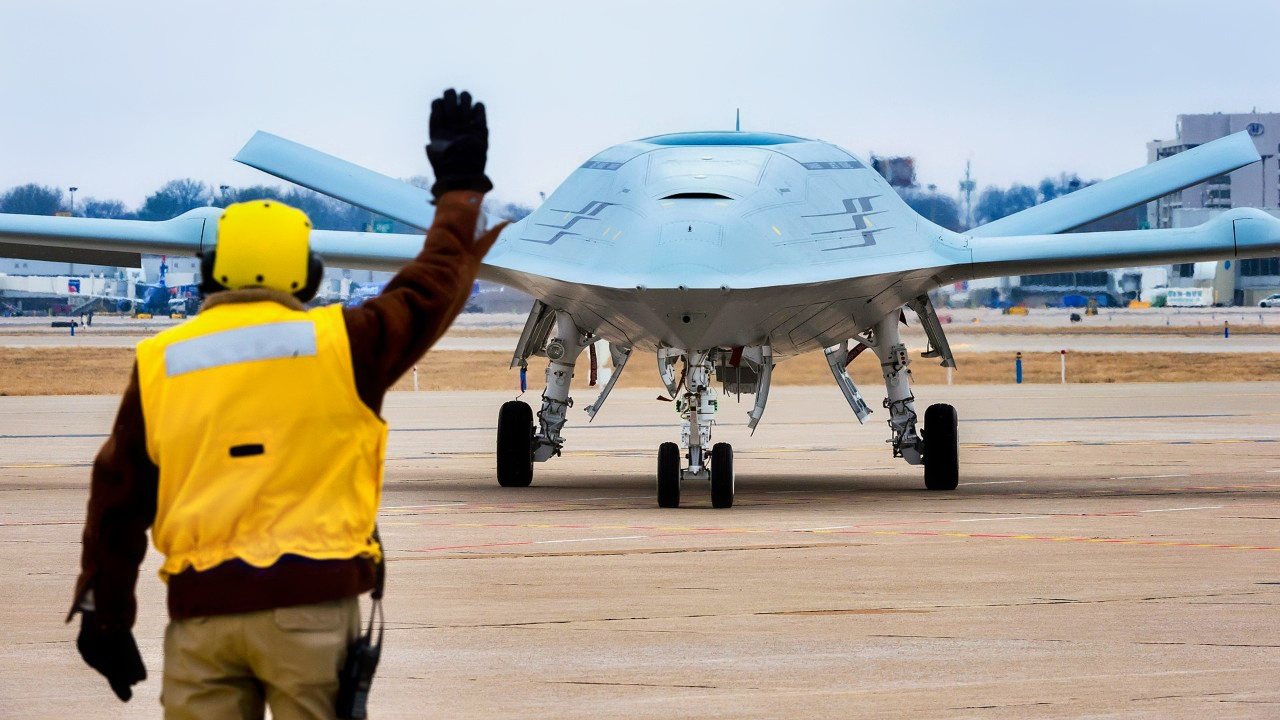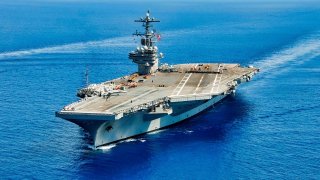The U.S. Navy Now Has a 'Drone' Aircraft Carrier
The USS George H.W. Bush (CVN-77), the final Nimitz-class supercarrier, has been equipped with the world's first Unmanned Air Warfare Center (UAWC). This upgrade allows the carrier to operate the Boeing MQ-25 Stingray unmanned aerial system (UAS), which is set to take over the aerial refueling role from the F/A-18 Super Hornets, thereby extending their service life. Some are now calling this a sort of drone aircraft carrier.
Summary and Key Points: The USS George H.W. Bush (CVN-77), the final Nimitz-class supercarrier, has been equipped with the world's first Unmanned Air Warfare Center (UAWC). This upgrade allows the carrier to operate the Boeing MQ-25 Stingray unmanned aerial system (UAS), which is set to take over the aerial refueling role from the F/A-18 Super Hornets, thereby extending their service life. Some are now calling this a sort of drone aircraft carrier.
-The UAWC features the Unmanned Carrier Aviation Mission Control System (UMCS) MD-5E Ground Control Station, enabling Air Vehicle Pilots to control the MQ-25 directly from the carrier.
-The first sea testing of this system is scheduled for next year. The MQ-25 will initially focus on refueling but may also be used for intelligence, surveillance, and reconnaissance (ISR) missions in the future. This upgrade represents a significant step toward integrating unmanned systems into the Carrier Air Wing and Carrier Strike Group operations, laying the groundwork for future unmanned capabilities across the U.S. Navy’s carrier fleet.
Nimitz-Class Supercarrier Equipped for Future with MQ-25 Stingray Drone Operations
A United States Navy's Nimitz-class nuclear-powered aircraft carrier has been upgraded with the "world's first Unmanned Air Warfare Center (UAWC)," which will allow the flattop to operate the future Boeing MQ-25 Stingray unmanned aerial system (UAS), Naval Air Systems Command announced.
USS George H.W. Bush (CVN-77), the tenth and final Nimitz-class supercarrier, is the first warship to receive the UAWC, which was installed as a part of a "multi-year effort coordinated across multiple ship availability periods" while accommodating the carrier's "deployment schedule." Now that it has been installed, the UAWC will allow Air Vehicle Pilots (AVPs) – aka drone operators – to control the Boeing-made UAS directly from the warship.
The UAWC is equipped with software and hardware systems that include "the first fully operational and integrated Unmanned Carrier Aviation Mission Control System (UMCS) MD-5E Ground Control Station (GCS)," which is "system-of-systems" required to control the MQ-25 Stingray – the first carrier-based UAS employed by the U.S. Navy.
The Stingray was developed to provide aerial refueling to carrier-based aircraft, replacing the Boeing F/A-18 Super Hornets that are currently utilized in that role, which accounts for 20 to 30% of their flight time, according to Aero Time. Transferring this role to the UAS will help extend the life of the sea service's Super Hornets.
The first sea testing of the UAWC's operational networks on CVN-77 is scheduled to begin next year, and while the MQ-25 will initially be employed in refueling, the drone could be used in intelligence, surveillance, and reconnaissance (ISR) capabilities that enhance capacity and versatility for the Carrier Air Wing (CVW) and Carrier Strike Group (CSG).
"This will be the first time the AVPs from Unmanned Carrier-Launched Multi-Role Squadron (VUQ) ten will operate the MD-5 from an aircraft carrier. They will use the actual GCS hardware and software aboard CVN 77 to communicate with a simulated air vehicle in the lab in Pax River," said Joe Nedeau, Unmanned Carrier Aviation (PMA-268) UMCS lead.
Current U.S. Navy plans call for all Nimitz-class and Gerald R. Ford-class carriers to eventually be MQ-25 capable.
"The MQ-25 brings the right combination of refueling, autonomy, and seamless carrier deck integration to meet the U.S. Navy's goals," Boeing stated.
"CVN 77's UAWC lays the foundation for how the U.S. Navy will operate and control unmanned aircraft, and perhaps other unmanned vehicles, with UMCS," added PMA-268 Program Manager Capt. Daniel Fucito. "These systems will initially support the MQ-25 but also future unmanned systems such as Collaborative Combat Aircraft that comprise the Air Wing of the Future."

Aerial refueling from the MQ-25 T1 test asset has been conducted with three carrier-based aircraft including a F/A-18 Super Hornet, an E-2D Advanced Hawkeye, and a F-35C Lightning II.
The Boeing-owned MQ-25 T1 test asset served as a predecessor to the engineering development model aircraft being produced under a 2018 contract award.
The refueling drone has a total length of fifty-one feet, and a wingspan of seventy-five feet unfolded/31.3 feet folded. It is powered by a Rolls-Royce AE3700N engine, which provides a range of 500 nautical miles (580 miles) while carrying approximately 16,000 pounds (7,250 kg) of fuel.
About the Author: Peter Suciu
Peter Suciu is a Michigan-based writer. He has contributed to more than four dozen magazines, newspapers, and websites with over 3,200 published pieces over a twenty-year career in journalism. He regularly writes about military hardware, firearms history, cybersecurity, politics, and international affairs. Peter is also a Contributing Writer for Forbes and Clearance Jobs. You can follow him on Twitter: @PeterSuciu. You can email the author: [email protected].
Image Credit: Creative Commons and/or Shutterstock.


